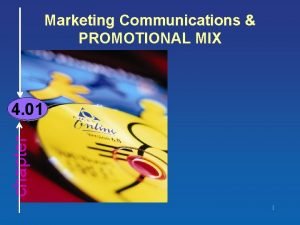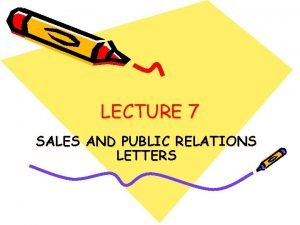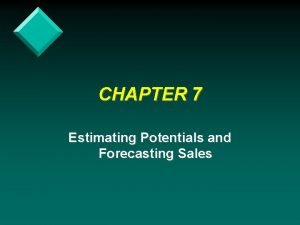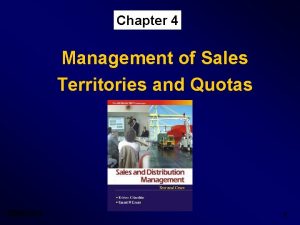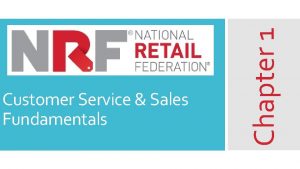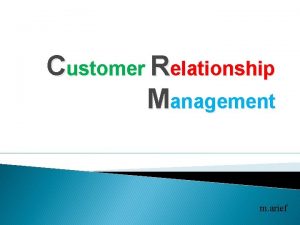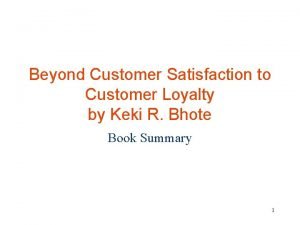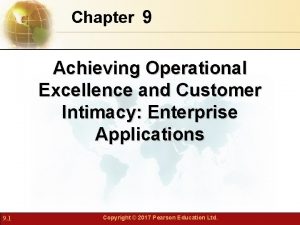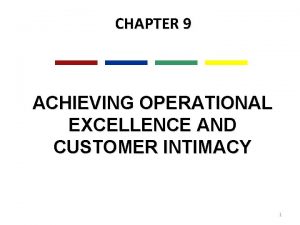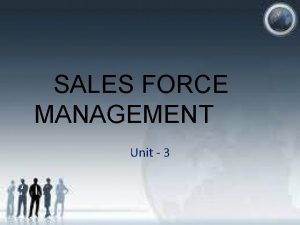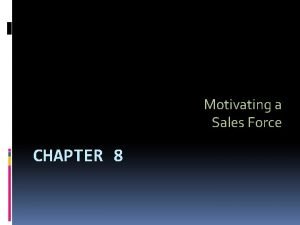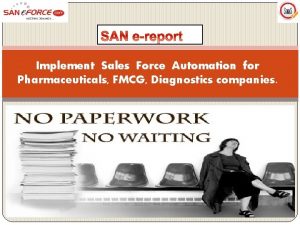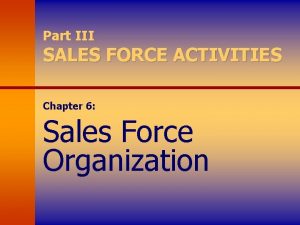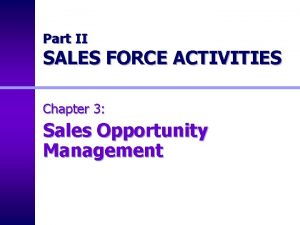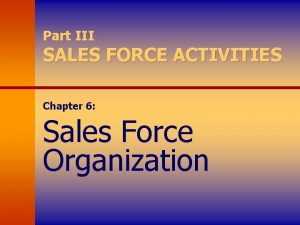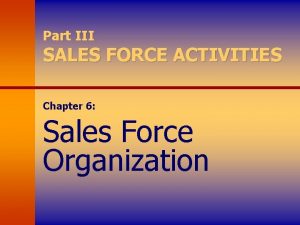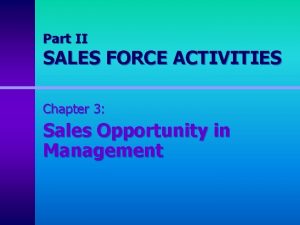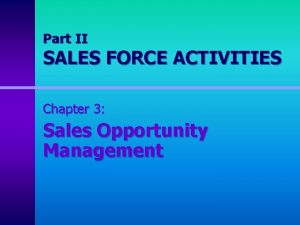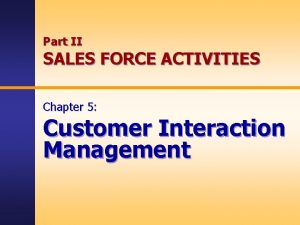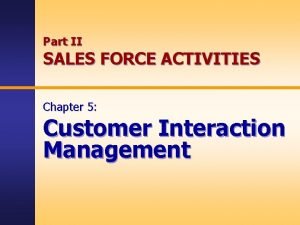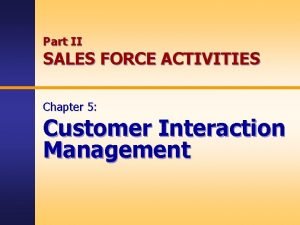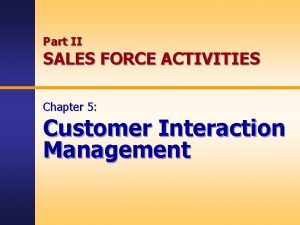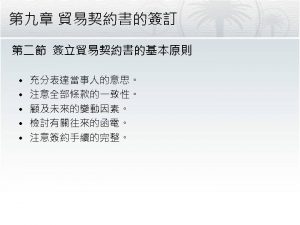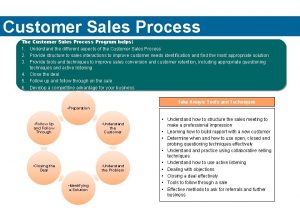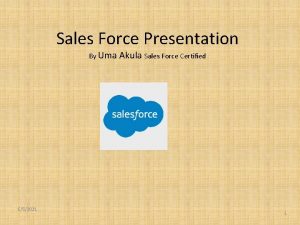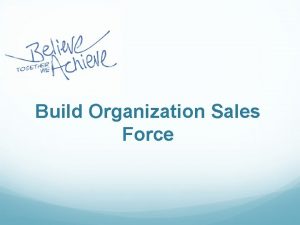Part II SALES FORCE ACTIVITIES Chapter 5 Customer




















- Slides: 20

Part II SALES FORCE ACTIVITIES Chapter 5: Customer Interaction Management

Improving Your Chances of Success 1. Build awareness 2. Get on the short list 3. Demonstrate how your proposal meets company needs 4. Directly address decision maker’s personal needs 5. Be prepared for “buyer remorse”

Personal Selling The Selling Process PREINTERACTION Skills: n n Setting Objectives Knowledge Management Information Gathering Rehearsal INTERACTION Skills: n n n Gaining Access Relating Need discovery Advocating Closing POSTINTERACTION Skills: n n Supporting Implementing Dealing dissatisfaction Enhancing the relationship Figure 5 -1: The Selling Process and Skills

Customer Interaction Pre-Call Planning § What do I want to accomplish? § What do I know about the prospect? § Where can I find the information? § What am I going to say?

Customer Interaction What is the size of the business? What product lines do they sell and what markets do they serve? Where, how, when, why, and by whom will the products be used? Who are the prominent executives and other key personnel? Who are their competitors and on what basis do they compete? Do they have any previous experience with our company? What are the prospects for future sales volume and what is the upside potential? Figure 5 -2: Some Important Pre-transactional Information

Successful Salespeople Less Successful Salespeople Research Prospect Background Do Little background research Use referrals for prospecting Use company-generated prospect lists Open by asking questions Open with a product statement Use needs-satisfaction type presentation Use standard presentation Focus on customer needs Focus on product benefits Let prospect make purchase decision Close by focusing on the most important customer objection Figure 5 -3: Successful versus Less Successful Salespeople

Customer Interaction Anticipate Buyer Questions 1. Who is your company? 2. What is your record for support and service? 3. What are you selling and what kind of person are you? 4. Who else is using your product? Are they satisfied? 5. How does your solution compare to alternatives? 6. Why do I need it? Why do I need it now? 7. How much does it cost? Is your price truly competitive? Figure 5 -4: A Client’s Questions

Customer Interaction Means of Reducing Relationship Anxiety PROPRIETY Show buyer respect; dress appropriately COMPETENCE Know your product/service; third-party references COMMONALITY Common interests, views, acquaintances INTENT Reveal purpose of call, process, and payoff to the buyer Figure 5 -5: Means of Reducing Relationship Anxiety

1. Does not understand our business 2. Inadequate product knowledge 3. Does not respond to our needs 4. Does not listen to our needs 5. Should be more of our advocate 17% 15% 13% 12% 11% Percentage of Customers with complaint Figure 5 -6: Top Five Customer Complaints About Salespeople

Customer Interaction Task Motives PRODUCTIVITY Financial More Output or Quality Less Cost Less Effort More Profit

Customer Interaction Personal Motives Respect Power Approval Recognition

Customer Interaction Needs Discovery: Types of Questions 1. Permission Close-ended 2. Fact-finding Factual information 3. Feeling finding Open-ended questions 4. Checking questions Confirm understanding

Type of Question Purpose Example Permission A close-ended question “May I ask you a few asking the other person’s questions about your current permission to ask questions shipping process? ” or probe further into a subject. Fact-Finding A question focusing on factual information about the business, person, or current situation. “Who is your current supplier of sutures? Do you have a JIT arrangement with Ethicon in supplying sutures? ” Feeling-Finding An open-ended question that tries to uncover feelings about a situation and potential consequences of the situation “How do you feel about your current inventory levels in sutures? What effect does this level of inventory have on your operating costs? ” Checking A question for checking one's understanding and getting agreement concerning the statement. “If I understand you correctly, you have said that you are happy with the quality of your current supplier, but feel that you may be able to get the same quality of service at a lower price from another supplier. Is that accurate? ” Figure 5 -8: Discovery Process: Types of Questions

Customer Interaction TRANSACTIONAL RELATIONSHIPS CONSULTATIVE AND ENTERPRISE RELATIONSHIPS Practices: n Focuses on closing sales n Focuses on customer’s bottom line n Limited call planning investment n Considers call planning a top priority n Spends most contact time telling account about products n Spends most contact time attempting to build a problem-solving environment n Conducts “product-specific” needs assessment n Conducts discovery in the full scope of the account’s operations n “Lone wolf” approach to the account n Team approach to the account n Proposals and presentations based on pricing and product features n Proposals and presentations based on profit-impact and on strategic benefits. n Sales follow-up is short-term, focused on product delivery n Sales follow-up is long-term, focused on long-term relationship enhancement Figure 5 -9: Key Differences in Practices Between Relationships

Customer Interaction Sales Proposals – General Format § Problem Analysis § Solution § Product Specifications § Cost-benefit Analysis § Contract

Customer Interaction Handling Concerns Listen to the buyers feelings Share concerns without judgment Clarify real issue with questions Problem-solve present options and solutions Ask for ACTION to determine commitment

Customer Interaction Pseudo-Concerns “I’ll have to talk it over with Frank. ” “I’ll get back to you. ” “I’m too busy right now. ” “Our budget is tight this year. ” “We have no room to store it. ”

Customer Interaction Closing Techniques IMPORTANCE BY PRODUCT Selling Technique Industrial Consumer Ask for the order in a straightforward manner 1 1 Summary § Summarize the benefits already covered in the presentation 2 2 Single Objection § Asks for the order if last obstacle is overcome 3 4 Assumption § Assume readiness to buy and focus on the transaction details 4 2 Choice § Focus on version to be ordered 5 5 Direct n

Customer Interaction 31% Most Profitable Return Top 3 Rankings for Growth 63% 87% Rated Very Important to Growth 11% 32% 62% Quality of service to customers Product improvements or extensions 3% 8% 16% 22% 26% 34% 59% 58% 49% Information technology Advertising and sales promotion Development of entirely new product lines Figure 5 -10 : The Role of Customer Service

Customer Interaction Sales Support the Buying Decision Manage the implementation Deal with dissatisfaction Enhance the Relationship Figure 5 -11: Servicing the Sale: The Four Pillars of Sales Support
 Sales organizational structure
Sales organizational structure Pengertian sales force
Pengertian sales force The statement of cash flows helps users
The statement of cash flows helps users Outdoor and indoor sports
Outdoor and indoor sports Primary and support activities
Primary and support activities Tertiary activities definition
Tertiary activities definition Types of promotion
Types of promotion Difference between sales letter and sales promotion letter
Difference between sales letter and sales promotion letter Sales force composite
Sales force composite Sales quotas and sales territories
Sales quotas and sales territories Nrf customer service and sales
Nrf customer service and sales Using marketing information to gain customer insights
Using marketing information to gain customer insights Customer relationship management and customer intimacy
Customer relationship management and customer intimacy Pengertian customer relation
Pengertian customer relation Beyond customer satisfaction to customer loyalty
Beyond customer satisfaction to customer loyalty Customer relationship management and customer intimacy
Customer relationship management and customer intimacy Intimacy
Intimacy Meaning of sales force management
Meaning of sales force management Aplikasi sales force automation
Aplikasi sales force automation Motivating sales force
Motivating sales force Fourrts e reporting
Fourrts e reporting






